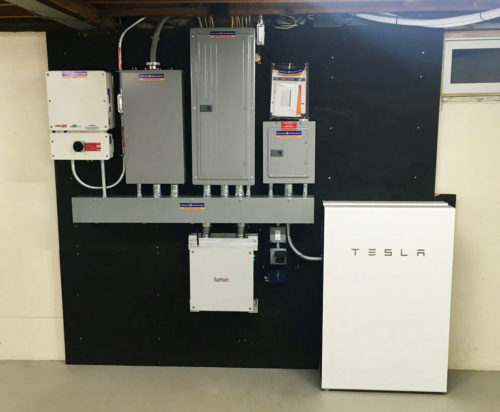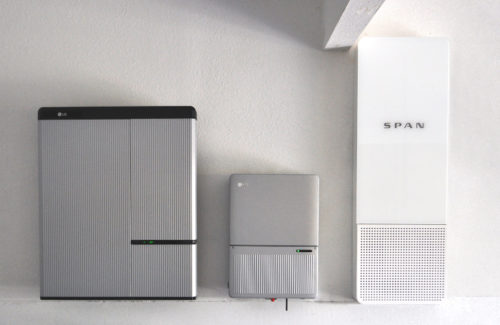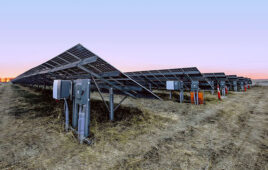With the advancements of the Internet of Things and whole-home automation, it is surprising that easy management of energy storage systems isn’t included in the equation. When a homeowner hooks up a battery, typically only a few circuits are rewired for energy backup. The bedroom lights may not get that emergency power, but at least the refrigerator and air conditioner are still running.
This tends to be the biggest education hurdle for installation companies — explaining that the lithium batteries on the market can’t actually provide whole-home backup. Morgan Brawner, VP of business development at SunPower by esaSolar, said this conversation is often challenging for the Central Florida installer. Many customers are interested in storage for hurricane-induced grid outages, and they believe one Tesla Powerwall will provide power for the whole home.
“Energy storage is not a commodity that can just be quickly added as a line item and forgotten about,” he said. “It takes some real conversations about how much you can power with one battery. We use a ‘final configuration’ document when we complete our engineering package that our customers sign that clearly states which circuits we are backing up to ensure there are no surprises on the day of installation.”
New generation electrical panels and smart circuits can change that conversation. Instead of only backing up a few loads through a protected loads panel, smart circuits and energy management software allow for load toggling — someone can stop supporting the air conditioner for a little while to instead turn on some lights.
That ability to choose or automate which circuits to support with energy storage is a major selling point of the hardware/software combo of Lumin. A physical box installed next to a home’s electrical panel, Lumin allows for whole-home backup (on varying schedules) by making all circuits smart. Through an app, system owners can manage their energy usage and protect their batteries from prematurely running out of juice.
SunPower by esaSolar has installed Lumin on about one-quarter of its battery projects and expects that number to climb as the storage market continues to grow. Brawner described Lumin as a “game changer” for homeowners to better connect the monitoring experience with real-time usage behavior. Rather than just monitoring the battery, Lumin can actually manage use.
“I think the future of PV and energy storage will involve a lot more innovations in smart energy management to provide better transparency to energy behavior trends and home energy use,” he said.
Lumin launched in 2016 as a way to advance the adoption of green energy by improving the technology of tried-and-true breaker panels. Instead of replacing the home’s breaker panel with a brand new configuration, Lumin is a simple add-on that works with any battery brand and electrical panel, said company co-founder and CCO Kevin O’Shea.
“Replacing an existing breaker panel with an entirely new one is very costly in terms of time and labor before you even add on the cost of the product itself,” he said. “Our approach allows us to meet the market demand for smart and responsive load control without that large upfront cost.”
Another product in the nascent smart circuit market is Span’s electrical panel. Unlike Lumin, the Span Smart Panel replaces the traditional circuit breaker panel to become the primary energy and control hub for a home. Instead of juggling the upkeep of two boxes, Span makes all circuits smart at their source.
Launched in select markets in 2019, Span provides smart customization for 32 circuits. When power goes out, the Span Smart Panel isolates the house and allows the customer to control important loads via a smartphone app. Span, which is led by executives and engineers previously with Tesla, Amazon and Sunrun, has established relationships with LG Chem and Panasonic, with the battery companies offering Span as a packaged deal. The panel is currently available in California and Hawaii, with new markets coming soon.
“Self-sufficiency and control within the home are top of mind for many homeowners with power outage concerns now compounded by coronavirus shelter-in-place orders,” said Span founder and CEO Arch Rao in a press release. “Last fall, power outages affected millions in California, and shutoffs are starting again as utilities perform precautionary maintenance in fire-risk areas. We developed the Span smart panel to give homeowners greater energy independence in the face of these growing challenges. With Span, they have greater control over their home energy, especially when they need it most.”
While it’s true that battery companies offer monitoring through their own apps, they don’t give the user any control. A smart circuit setup can monitor charging levels while also providing load control. O’Shea said the Lumin system remains on “watch mode” to automatically govern loads. It makes sure the home’s microgrid doesn’t prematurely run out of backup power or exceed the battery’s output rating — something that many end-users don’t give a second thought.
“Imagine driving a car without a fuel gauge. What’s more, the car starts driving itself whenever the power goes out, regardless of how much gas is in the tank,” O’Shea said. “You just spent [upwards of] $20,000 on a battery backup system to make sure the car doesn’t run out of gas. It really isn’t acceptable to leave it up to chance whether or not that car runs out of gas, especially given that it starts itself and runs automatically when the power goes out.”
O’Shea said it’s the responsibility of energy management technology like Lumin’s to protect customers from “running out of gas” unexpectedly or too quickly.
Both Lumin and Span have met the UL standard for energy management equipment (UL 916), while Span also passes UL 67 as a regular electrical panel. The next hurdle for these smart circuit companies is wider market adoption. Brawner with esaSolar thinks that’s only a matter of time.
“For PV monitoring, homeowners want to see insights on if their system is producing power and if there are any issues. After a few months, it becomes like watching paint dry. For storage, the monitoring applications are very much the same,” Brawner said. “That is the problem that Lumin solves. For a homeowner, the Lumin is providing real-time engaging information to bridge the gap between technical monitoring and home energy use.”








I’m getting some batteries installed for my solar PV system. The battery system power = about 6.5KW and energy = 20KWh. Is there any reason that I can’t just put all my house circuits on the backup panel? I realize that I’d be power-limited but none of my high-power loads, except the AC would ever automatically turn on. When the grid’s down, I would just have to remember what loads I have running when deciding to turn on another load. In other words, why do I even need a backup panel? Couldn’t one just manually limit the loads applied during the outage?
Span? Or Lumin? that is the question.
I know this was from last year, but I am having an issue with my battery back up plans connected to our solar array and was wondering if anyone could advise us. We are being told that our AC can not run on the battery at all because it is on a 60 amp circuit. Everything I read including this article mentions using an AC for various amounts of time but doesn’t indicate they can’t be used at all. Is my AC just way oversized for a battery? It was just a regular AC for a normal sized home that was supposed to be energy efficient and made by Lennox about 10 years ago. But no battery seems to be able to handle it. Using the AC in an outage was the primary reason we considered battery back up in the first place. Any thoughts anyone has would be appreciated.
The Amps (power) required to start your AC unit must be more than your battery can produce when the grid is down. This is either a limitation of your battery or your inverter. Your AC unit has a placard that indicates the Locked Rotor Amps (“LRA”) that are required to start it up. Your battery and inverter must be able to produce that amount for a brief period to get the system going. Sometimes you can install an after-market “soft start” device, like Hyper Engineering’s “Sure Start,” that can dramatically lower the starting amps required to turn on your AC unit…and allow your battery and inverter to meet the power requirements to start it when you are in backup mode. Note, it is not the “60A Circuit” rating (Circuit Breaker), but the LRA rating of the AC unit that matters. Finally, sometimes adding another or a larger battery will allow you to output enough “surge” current to start the AC unit…but that depends on your system. Good luck. Hope this helps or was at least informative.
The technology around solar-systems and renewable power production can be mind-boggling for a layman like me. I have built a 6kw solar-array that includes microinverters (for simplicity sakes) approximately 500ft from my house. The feed-line ties directly into the grid at the power pole which is connected to the dwelling in the opposite direction. The system works fine, but to this day I have no back-up in case of a power failure. I simply haven’t found an electrical contractor who could tell me what automatic isolation device on the market would be suitable for my application. This is of course a rural setup which doesn’t apply to towns and cities where the grid is connected directly to the house, I would assume. Unfortunately, none of this promising technology can be applied in my case, until the mandatory isolation requirement has been solved.
The direct grid tied mentioned is an Achilles heel of your system. Micro inverters like (Enphase) do have a ‘system’ that can island and support some critical circuits in your house during a power outage. You’d have to take the grid connection off of the power pole and into a secondary Circuit Breaker panel, with a break before make automatic transfer switch, between the secondary and primary C.B. panels.
Technology has changed so much in the last 5 years. The Smart ESS is probably the best (value) at a higher cost than the old simple series wired panel strings, paralleled into the “house inverter” then out into the grid through the house C.B. panel. It is possible to use the smart ESS intrinsic grid interactive inverter as a programmable house inverter or off grid back up inverter.
Whenever there is a new technology for solar or even new racking or tracking vs non-moving racking, as the solar panel system contractor, i always have a big learning curve to adjust to. AND, my electrical contractors and installers do too. The problem always lands on my shoulders since both the electrical contractors and installers do not always quite understand. Then, I usually end up making nothing on the first job. And that customer is upset because he/she thinks that I am a dunce. Also, trying to get my potential customers to understand the changes is often next to impossible. And, the new product manufacturer usually does not put their product spec sheets into a form that anybody but them can easily understand. All of this is very frustrating. It is great that our industry is adjusting to the new environment. But the progress often is slower than expected.
I appreciate all that you do! Thank you for not doing rush jobs and actually taking the time to understand what you are installing.
“New generation electrical panels and smart circuits can change that conversation. Instead of only backing up a few loads through a protected loads panel, smart circuits and energy management software allow for load toggling — someone can stop supporting the air conditioner for a little while to instead turn on some lights.”
The Sonnen ecolinx can do this and has just released a ecolinx 30.0 ESS, 24kWh usable with 20% emergency if needed. In Germany Sonnen was designed for the interactive grid from the start, with the ability to take weather data and determine how much energy to store, how much to use right now. With smart home appliances Sonnen can be communicating with specific appliances and one can control loads in the house with an App on a smart phone. GENERAC has just announced a partnership with a company that is doing smart energy control and VPP.
“That ability to choose or automate which circuits to support with energy storage is a major selling point of the hardware/software combo of Lumin. A physical box installed next to a home’s electrical panel, Lumin allows for whole-home backup (on varying schedules) by making all circuits smart. Through an app, system owners can manage their energy usage and protect their batteries from prematurely running out of juice.”
We have been institutionalized in the “brute force” method of power to one’s home. You take a 200 Amp circuit breaker panel times the 240VAC buss structure and you get roughly 48,000 watts continuous. The reality is surge accommodation is around 48,000 watts maximum, but the actual load on the home’s C.B. panel at any one time may be 80 to 125 Amps maximum. The smarter the system, the more loads can be powered. Go to your electric panel now and look closely at it. On top is the house Main rated at (100), (200) Amps, then count and add up all physical circuit breakers in the panel. I’m pretty sure you’ll find if you loaded every plug in the house, turned on all appliances, lights, ceiling fans and the A/C unit(s) and water heater, you’d probably trip the house breaker every time. In this day and age many air conditioning units have a power fail wait timer, so when the utility restores power, the large surge of the A/C unit is not immediate and usually 5 minutes of continuous power is needed before the A/C is allowed to restart. Many of the Energy Star devices from washers, cooktops, refrigerators/freezers and air conditioning units are now using variable frequency drives, these electronically controlled motors have power surges from 40 to 50% less of an old across the line motor of the past.
I don’t believe the sonnen ecoLinx supports ALL circuits like the devices mentioned in this story. Still need a protected loads panel for the chosen circuits.
Thanks for that.
I was able to get up close and personal to a model home with a actually small solar PV array, maybe 2.5 to 3kWp on the roof and a sonnen ecolinx 20.0 in each garage. The development is by Mandalay in Arizona. The Sonnen was “locked” so I couldn’t scroll through the programming pages and menus. But the sales pitch was upgrade your energy efficiency package and you could “talk” to your smart home appliances, set the shades in the windows and turn on and set the air conditioning from a smart phone app, I believe these particular Sonnen units have an internet gateway that can communicate to the house appliances. When all is said and done, the smart interactive inverter is the way to go. Early on before Schneider bought out Xantrex, the XW6048 way back in 2008 was able to be programmed utility interactive and one could actually program in how much energy to sell to the utility and the rest was stored and used on site. With battery technology, and a little larger smart inverter one could run a home off of solar PV most of the time and use the utility as backup.
Just wanted to chime in and say it’s great to see the XW6048 getting some love 🙂 I’m off-grid and have been running off that unit for 12 years and it’s fantastic (I had an eaaaarly model and needed to self-replace a circuit-board but otherwise it’s been trouble-free for all these years). Don’t tell my solar friends this but we’re finally looking to add some grid power source and might finally unlock this feature.
Here is some info about Generac. They don’t have a smart electrical panel, but they can manage loads.
Generac’s PWRcell system works differently. This end-to-end system leverages native load management technology to work smarter and provide whole-panel backup power. When an outage occurs, the PWRcell Automatic Transfer Switch breaks the connection to the grid and the PWRcell Inverter directs backup power to the main panel. Meanwhile, Generac Smart Management Modules (SMMs) pause low priority loads if local demand exceeds the system’s backup capacity (up to 9kW with a single PWRcell battery). When demand is reduced and power is available, SMMs can allow lower priority loads to function again. SMMs can also shed circuits outright if desired. Up to eight circuits can be controlled via SMMs which wire inline in any convenient location, reducing the labor of retrofitting a smart panel or sub-panel. Additionally, the PWRcell ATS can control up to four thermostats to shed large HVAC loads in an elegant manner.
Thank you, that clears up some confusion of a system that can “island” critical home circuits.
The industrial controls industry as a whole usually have an (HMI) human machine interface, which many are in and of themselves self contained Computers with display screens in one unit. Tag based programming in these HMIs one can create many custom control programs for power flow in differing situations. Digital inputs from the on board ATS could be used to physically signal the system to switch into stand alone mode and island critical circuits in one’s home.